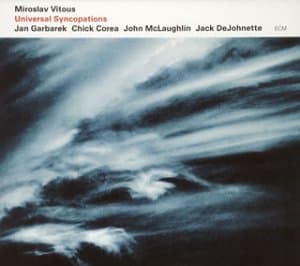
Miroslav Vitous Universal Syncopations
Value For Money
Miroslav Vitous Universal Syncopations
When you purchase through links on our site, we may earn an affiliate commission. Here's how it works.

User Reviews
Value For Money
Universal Syncopations Is Wonderful To A Point And
Universal Syncopations is wonderful to a point and that threshold lies somewhere between when all the other players had finished and the master tapes were handed over to Jan Garbarek to overdub his part. Man! He blows over everything, and that just about ruins it for me, perhaps not for the first time as this could also be thought about his intrusive playing on Zakir Hussain's Making Music.
This album marks Vitous' return from eight years of not touring and recording (last up was 1992's release Atmos just with Garbarek). Meanwhile, 3 years ago he launched three new sample libraries, The Miroslav Vitous Symphonic String, Brass and Woodwind Ensembles, designed for the NemeSys GigaSampler system. His taste for technology seems to have gotten the better of him; each player was recorded separately for Universal Sycopations, asked to respond in various ways to Vitous' bass. The result is that an element of group spontaneity has been lost to the recording process.
But, this defines a new direction for Vitous, one that he is very excited about and can be best heard on the new tracks Miro Bop and Sun Flower
This is where the bass doesn't play all the time. It's again breaking the traditional role of the bass, basically to set everybody free. When the bass stops playing, all of a sudden everybody's much more free because you have an equal thing going among the great musicians, and there's no one playing roles anymore. Immediately the drums become more free. Everybody becomes more free. It's a very liberating process.
Restrospectively, Universal Syncopations does retain an escence of the timelessness captured by Vitous' brilliant debut as leader on Infinite Search (1969), in that he has retained a freshness of discovery. That introductory album was produced by Herbie Mann and also featured John McLaughlin and Jack DeJohnette. The other participants were Herbie Hancock and a far more sensitive saxophonist in Joe Henderson who regarded space in a wholly different light to Garbarek. Therefore, although mostly lost under a veil of Garbarek's incessant saxophone, McLaughlin's tone is similar to his late 60s work, and when not annoyingly brazen, even Garbarek's phrasing gets fittingly close to the melliferous Wayne Shorter on cuts like Supernova, which coincidently was another meeting place for Vitous, Corea, McLaughlin and DeJohnette.
Universal Syncopations was co-produced by Vitous and ECM founder Manfred Eicher and is presented in typically stylish ECM packaging, except McLaughlin is pictured with an unlikely nylon-stringed instrument for this recording.
A highlight is the eminently hummable Tramp Blues, a Mingus-like punchy blues featuring the welcome expanded brass section of two trumpets and a muted trombone, whose sound are reminiscent of an earlier ECM era. When the horn chorus chips in it could be a Michael Mantler overture. With everybody (bar Garbarek) lost into the mix and a quite unimaginative overall performance by the usually mindboggling DeJohnette, Vitous can easily claim the star role with superb decorative chord phasing and skillful wending of his bassline through the music space. If the redefinition of the bass role is a side-effect of the recording process then perhaps it is not an entirely bad thing.
This is still a glorious virtual symposium of jazz greats that is a modern jazz treat when so much contemporary jazz has disappointed.
Q&A
There are no questions yet.